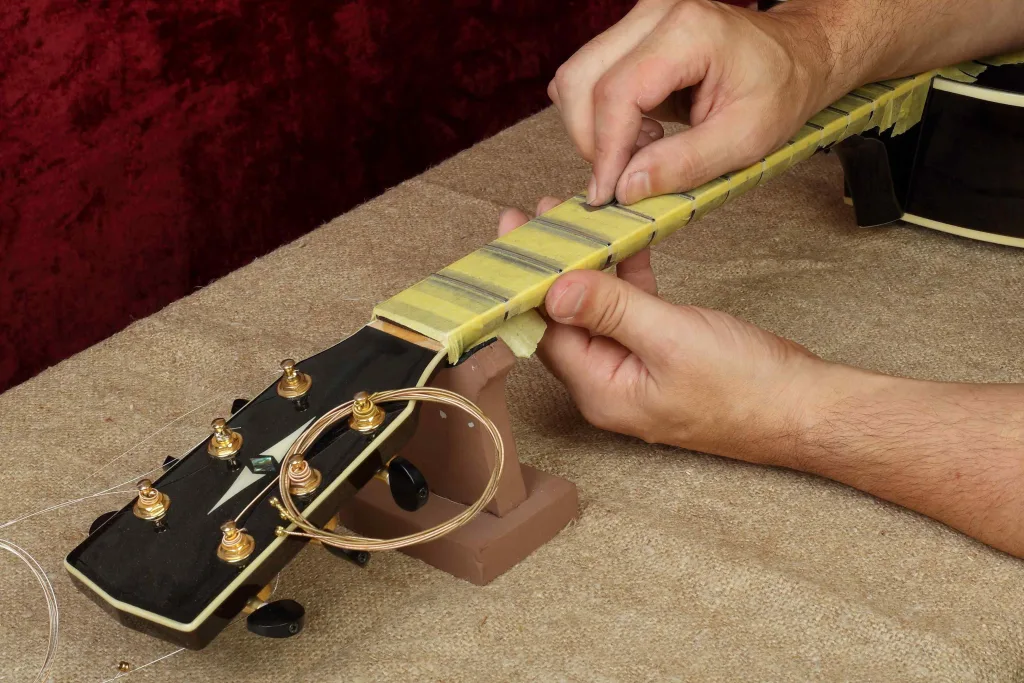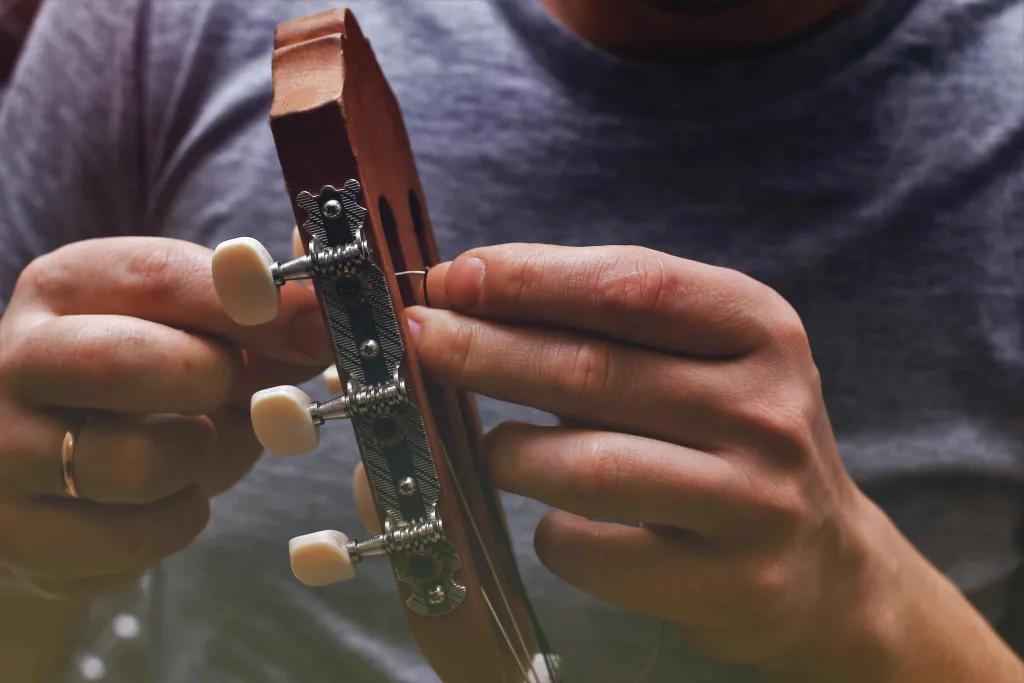Dead frets occur when the strings do not vibrate properly against the fretboard. This can be caused by a variety of factors, but the good news is that it’s usually fixable.
In this article, we’ll cover what dead frets are, what they sound like, and how to fix them. With the right tools and some patience, you can have your guitar playing like new in no time.
What are dead frets?
Dead frets are a common problem in guitars that occur when a fret becomes worn out, causing the string to produce no sound when played on that specific fret.
This wear and tear typically happen over time due to the constant pressure and friction from the guitar strings on the fretboard.
You can easily spot a dead fret by trying to play the same note on a different string. If the note still doesn’t produce any sound, it means the fret itself is the issue.
While you can temporarily work around this by playing the dead note on the next fret, it’s not a permanent solution.
It’s essential to address dead frets promptly to maintain the guitar’s playability and sound quality.
Seeking timely repairs or adjustments from a professional guitar technician can prevent further damage to the instrument and restore its full functionality.
New Guitars and Dead Frets: Can It Happen?
Even a new guitar may have a dead fret.
This could be due to bad handling during shipping or a manufacturing issue that wasn’t detected before the guitar was sold.
In either case, the fret should be addressed as soon as possible to avoid any further damage to the guitar.
To determine the severity of the dead fret, it’s important to know what it actually sounds like.
What does a dead fret sound like?
A dead fret will sound dead, with no note coming through, decaying rapidly with a tinny buzzing sound and no sustain.
It may be difficult to tell if a dead fret is the cause of the issue without listening to a few other frets first. Checking the condition of the fret is the best way to determine if it’s dead or not.
If the fret appears to be in good condition, it may be a sign of a truss rod or intonation issue. It’s important to check the fretboard, nut, and bridge to ensure all of the components are in good working order.
Causes for dead frets and how to fix them

If you’re experiencing dead frets on your guitar, there are a number of possible causes. We make a list of the most common ones:
Sympathetic Resonance
Sympathetic resonance occurs when objects vibrate together at the same frequency. For example, if you strike one tuning fork, another nearby tuning fork will vibrate in response. This phenomenon is powerful and even considered in building design.
In guitar maintenance, sympathetic resonance can be cause of a dead fret. This happens when playing a note causes another part of the guitar to vibrate at the same frequency, absorbing the note’s energy and causing it to decay quickly. On the other hand, wolf notes can amplify certain frequencies, making the note louder. To check if sympathetic resonance is causing a dead fret or wolf note, you can detune the string and observe if the position of the issue changes with the string tension. This helps rule out physical problems with dead frets.
Fixing Sympathetic Resonance
To address a dead fret caused by sympathetic resonance, you can try adjusting the weight at the headstock. This can be as simple as attaching a clip-on tuner or changing the tuning pegs.
Alternatively, you can explore products like the Fender Fatfinger, a weighted clamp designed to reduce dead frets and enhance sustain.
In certain cases, guitarists accept that wood, being an organic material, has its unique characteristics. In such situations, becoming more skilled at muting or dampening techniques may be the solution.
The approach taken depends on the severity of the issue.
Uneven or loose frets
In most instances, a dead fret occurs due to a physical issue with the guitar’s fretboard, where one fret is higher than the surrounding frets. This can happen when there is inadequate neck relief, which requires checking the straightness of the guitar neck and adjusting the truss rod accordingly. Other causes include loose frets, which we’ll discuss later, and uneven frets, caused by varying rates of wear.
Fixing uneven and loose frets
Checking for loose frets on your guitar’s fretboard is simple. Just take a small block of timber and press it firmly against the ends of the fret wires. If you notice any movement, it means you have a loose fret.
For minor cases, you can press the loose fret back into place or gently tap it using a fret hammer or small mallet.
In more severe instances, you may need to apply super glue. If you choose to fix it yourself, opt for thin super glue as it allows better penetration.
Apply the glue directly to the fret slot, where the tang of the fret wire is seated, using a toothpick or a similar small tool. Take precautions to avoid getting any glue on your fretboard by masking the area beforehand.
High Frets
If you experience dead frets, your fretboard may have high frets that need to be leveled.
Fixing High Frets
If you’ve identified a high fret, it needs to be carefully reduced to match the height of the surrounding frets.
This process involves using a fret file to file down the fret, followed by crowning and polishing.
However, unless you have experience or are working on a less valuable guitar, it is recommended to take your guitar to a luthier.
Fretwork is a specialized task that requires expertise beyond the scope of this article.
If you decide to proceed and have the necessary tools, it’s crucial to protect the fretboard by masking it or using fret guards that sit on top of the frets.
Gradually file down the high fret to achieve the same height. Then, use a 3-corner file or dedicated crowning file to shape the fret’s surface, reducing the contact area for the strings.
Afterward, polish the frets using 1200 grit sandpaper, followed by super-fine grade steel wool.
It’s important to proceed with caution as inexperienced attempts can result in damage that may require a complete refret if too much material is removed.
Old guitar strings

If your guitar strings are old, they may not provide the same level of tension they used to, causing your frets to sound dull and lifeless.
This can be a sign that it’s time to change the strings.
Replace the old stings
Replacing the old strings will help bring back the life and tone of your guitar.
Here are five things you should consider when replacing old guitar strings:
- Check the string guages and make sure they match your guitar.
- Look for corrosion on the strings and clean them with a soft cloth.
- Make sure the strings are wound properly around the tuning posts.
- Oil the fretboard to keep it in good condition.
- Stretch the strings after putting them on to ensure they keep their tension.
Replacing your strings is an important step in ensuring that your guitar frets sound as they should.
By taking the time to properly set up the strings, you can keep your guitar playing in top condition.
Bowing guitar neck
The bowing guitar neck is another cause of dead frets and can cause the entire group of frets to be dead.
To check the straightness of your guitar’s neck, follow these steps:
- Place a capo on the first fret and press down on the 14th fret (or the last fret on an electric guitar).
- Insert a business card or a similar straight-edge object into the space between the 7th fret and the thickest string on the fretboard.
- If the card fits without touching the strings and there is a noticeable gap, or if the card is difficult to insert without touching the strings, it indicates that your neck is not straight or may have excessive relief.
To adjust the neck, you can make changes to the truss rod located inside the neck. In some severe cases, there may be no gap at all between the 2nd fret and the guitar string, resulting in a dead fret where the note cannot be produced.
Warped neck
If the guitar neck is warped can be the cause of dead frets.
To address this issue, you’ll need to take the following steps:
- Identify the cause of the warp – this can be due to humidity, temperature, or incorrect string tension.
- Check the truss rod – this rod is responsible for maintaining a straight neck and can be adjusted to fix the warp.
- Adjust the nut and bridge – these are the parts of the guitar responsible for keeping the strings in the correct position and tension.
If the warp is too severe, or you’re unable to fix a dead fret yourself, you may need to seek professional help. A professional can assess the cause of the warp and repair the neck. In some cases, a neck replacement may be necessary.
Conclusion
Fixing dead frets on your guitar can be a daunting challenge, but with the right tools and techniques, you can get your guitar sounding great again in no time. With a bit of time and effort, you can get your guitar fretboard back to its original, lively condition.
FAQ
How much does it cost to fix dead frets?
When it comes to fixing dead frets, the cost can vary depending on several factors.
On average, you can expect to pay around $200 for parts and labor to fix normal frets on a standard guitar when working with a skilled luthier. However, it’s important to note that costs can be higher in certain cases. Luthiers often charge more for steel frets due to their increased difficulty to work with and the additional wear they can cause on tools. It’s always recommended to consult with a professional luthier to get an accurate estimate based on the specific needs of your acoustic guitar.
What happens if I don’t fix my dead frets?
If you don’t fix your dead frets, it can lead to a variety of issues. It can cause your guitar to sound out of tune and make playing difficult.
Over time, not fixing dead frets can also damage the guitar’s wood and cause further issues.
Ultimately, it’s wise to fix dead frets as soon as possible to avoid further damage and frustration.

